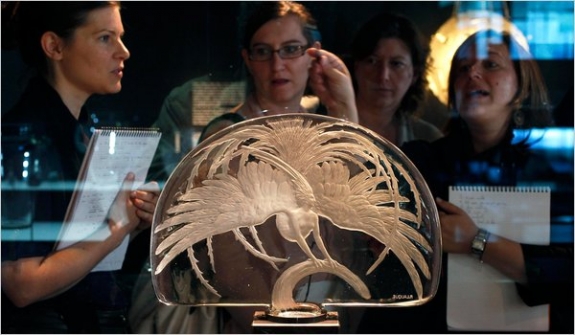The French luxury-glass maker Lalique has gone through three different owners in the past two decades, and its collection of design drawings and products, some dating back more than a century, ended up somewhat neglected in the shuffle. They have rarely been kept on regular view at the factory or the corporate offices.
Lalique’s current owner, Art & Fragrance, a Swiss company headed by the perfume magnate Silvio Denz, has helped create an all-Lalique museum that opens on July 2. French government agencies worked with Art & Fragrance to set up the Musée Lalique, with a dozen galleries built atop a ruined 18th-century glassworks in Wingen-sur-Moder, France, a village in Alsace near Lalique’s manufacturing plant.
About 650 artifacts are arranged by form and function, including vases, enameled floral jewelry and church windows molded with translucent saints.
Mr. Denz has lent about 230 of his own perfume bottles, including an 1890s teardrop-shaped vessel that the company’s founder, René Lalique, molded at the kitchen stove of his Paris apartment. His experiments caused a fire that devastated his home, but he was able to salvage the bottle.
The museum has recreated a 1930s glass fountain with leaping fish, and the roof beams have been reinforced to support a spiky chandelier from the 1950s that weighs about two tons.
Some of the material on display came from a 2005 Paris auction of the estate of Marie-Claude Lalique, René’s granddaughter, who died in 2003. (She had sold her share of the company to a French corporation about a decade earlier.)
Other recent sales of Lalique material have been held at Christie’s in London, which has organized all-Lalique auctions twice a year for two decades, and at Heritage Auctions in New York, which started annual art glass sales in 2009.
Prices reach six figures for the more imposing pieces. Last week at Sotheby’s in New York, a five-foot-long 1920s ceiling fixture molded with pineapples and pomegranates brought $254,500. (The estimate was $150,000 to $250,000.) A milky rectangle, the piece hangs from cylinders shaped like bamboo stalks; René Lalique created the design for the dining room of a prince’s palace in Tokyo.
The ranks of Lalique buyers have been growing lately, particularly in China and Korea, said Nicholas Dawes, Heritage’s vice president for special collections. “There are very few French collectors, oddly enough,” he added.
Many American collectors have donated their Lalique to museums in recent years and have financed acquisitions, and a handful of institutions keep their holdings on long-term view. At the Chrysler Museum of Art in Norfolk, Va., a few dozen vessels are on the gallery shelves, including vases with fish, feather and mermaid patterns. In October a new wing at the Chazen Museum of Art at the University of Wisconsin, Madison, will display about 30 Lalique objects. The Chazen goblets, vases and perfume bottles are molded with pine needles, grapes, butterflies, scarabs, parakeets and grasshoppers.
CEREMONIAL SNUFFBOXES
In the 18th century European diplomats gave one another porcelain snuffboxes with jeweled gold rims as rewards for loyalty in political alliances. The givers knew that the boxes were more likely to be put on display than filled with snuff, and that the jewels might well be removed and sold in hard economic times.
“This was a ceremonial gesture more than something for use,” said Nette Megens, a European ceramics specialist at Bonhams in London.
On July 5 the auction house will offer about 75 snuffboxes made in the 18th and 19th centuries, some with plain metal frames added later to replace originals encrusted with garnets and rubies.



